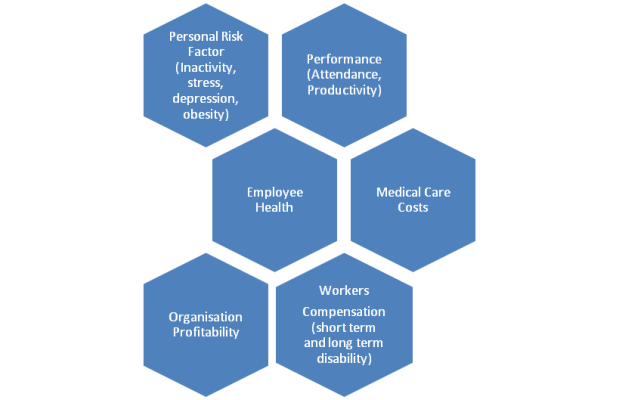Why employee well-being is an integral part of business

Unlike structural capital, human capital provides intangible contribution – intelligence and innovation, which are not reflected in the financial statements, but these intangible contributions drive every aspect of an organization’s operations from technology and product design to distribution network and service. Therefore, the well-being of employees is indeed in the best interest of communities and organizations. Statistics shows the average adult spends as much as a quarter or perhaps a third of his or her active life at the workplace. Therefore, motivated people are most prized asset for a company, which results in productive outcomes. Positive emotions broaden scope of attention, cognition leading to successful outcomes and better performance ratings for an employee.
A happy and healthy workforce is more cooperative, time-efficient, stay with the company longer and that is why employee satisfaction is linked to business-unit outcomes, such as employee turnover, customer loyalty, productivity and profitability.

What is employee well-being? – is it a new concept or a smart packaging of traditional absence management, occupational health and employee benefits?
To answer this question, we need to understand the changing dynamics at the workplace. The significant changes to work site demographics over the past decade are:
- The aging of the workforce
- High percentage of workers with multiple risk factors
- Higher number of women
- Growing number of people with higher aspiration
- Increased cost of living
| Method | Identifies |
| Employee health records | Common risks and health trends, daily habit, interests |
| Office environment audit (specially applicable to site/factory) | Potential physical hazard |
| Work place culture audit | Employees perceptions, involvement, frequency of engagement activity |
| Regular biometric health screening (Regular check up – BP, Cholesterol, Sugar etc) | Classify high risk employees and population-wide risk stratification |
| Productivity survey | Result can be used to investigate possible impact of health risks on attendance |
| Medical claims data analysis | Family dependents, family medical history |
So, today employee well-being program is no more limited to just providing medical insurance. It is essential to explore the underlying issues that govern human health and behavior at workplace and then HR can determine specific type of work site program, policy and incentives to promote employees’ health.
Building Healthy Organizational Cultures: There is no ‘one size’ fits all
Over the past decade, the trend for work site wellness has shifted to a broader framework of informational, educational and motivational programs and activities. The holistic approach is designed to promote the physical, emotional and social aspect of a person’s life.
New-age workplace: Traditionally work environment was defined as the physical characteristics of the workplace, including safety policies, environmental conditions like lighting, noise level, air circulation, hygiene and cleanliness and ergonomically adapted equipment and furniture. Now, the concept of the work environment has been extended to include healthy menu at cafeteria, anti-smoke policy, work site gym and indoor game facilities to motivate people to participate in physical activities.
Health-centric employee engagement: Post prompts at locations, eg: ‘Take a few steps to lose extra calories’ to encourage employees to avoid the usage of elevators. Weekly health centric recreational classes like yoga, light aerobics, screening of a sports film or forming a hobby group for outdoor activities over weekend like trekking with colleagues, posting travelogue on intranet, healthy recipe contest, celebrating local festivals through cultural program etc can be proved as effective measures to orient people towards active lifestyle and facilitate team bonding at the same time.
Employee well-being culture set up: Annual sports activity with active participation from senior management, using incentive like discount coupons for fitness club membershipetc for excellent attendance, special recognition by management for employees taking part in external or internal tournaments, hosting session on health, safety practices, nutrition etc by renowned professionals at office premise at regular interval, emails on health tips, implementing smoke free and safety belt policies in all company vehicles and facilities – all these practices help people to stay engaged at work place and also it helps employees to distress.
Besides implementation, it is also challenging for an employer to engage more and more employees in work – site wellness programs. Overall, the wellness interventions are more likely to be effective if it is incorporated on ecological perspective – target not only individuals, but also, interpersonal, organizational and environmental factors influencing health behaviours. Therefore, the involvement rate is always higher when we implement a new practice through departmental contests or challenging Team Avs Team B instead of awaiting for individual to embrace a new practice.
In fact, lifestyle change interventions are more effective when it includes individual health risk assessment, gender-specific programming, couple-specific programming & family targeted programming.
Once employees initially engage in targeted wellness programs, it is essential to keep them engaged over the long period in order to generate a favorable return on investment. It is important to include employee representation and feedback in wellness program selection to make it employee-focused and popular. In today’s competitive business environment, it is inevitable for HR team to invest in human capital innovatively in order to make the health and work equations add up to a higher performing organization.











